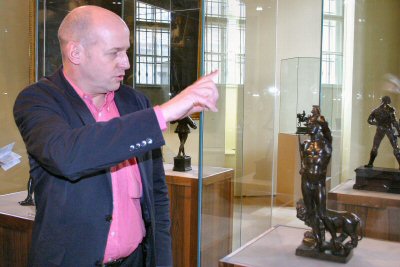Art & Exhibitions
Freshly Attributed Michelangelo Bronzes May Not Be Michelangelo’s After All
A German expert has cast serious doubts over the Fitzwilliam Museum's claim.
A German expert has cast serious doubts over the Fitzwilliam Museum's claim.
Henri Neuendorf

German art historian Frank Zöllner expresses serious doubts over the legitimacy of the recently unveiled ‘Rothschild Bronzes’ attributed to Michelangelo (see Michelangelo’s Only Surviving Bronzes Discovered). In an article published in the German daily Die Welt, the Michelangelo expert asserts that the attribution of the sculptures to Michelangelo is potentially “Flawed.”
The three-foot-tall sculptures depicting a naked man riding on the back of a panther were unveiled at the Fitzwilliam Museum in Cambridge, England last week.
Zöllner explains that the total absence of historical documentation detailing Michelangelo‘s creation of the bronzes is highly problematic. Taking into account the extremely complex and expensive casting process, he argues that it is very unlikely that the artist would have been able to create the sculptures in his studio without leaving behind any documentation, and without assistance.
Moreover, the expert alleges that the Fitzwilliam Museum’s authentication was based on a flawed visual and stylistic comparison made between the two sculptures, and a portfolio attributed to Michelangelo’s studio which contains a number of sketches, including a small sketch of a naked man riding a panther. He labels this approach “a little tricky, especially with such an adventurous attribution.”
Zöllner points out a series of crucial differences between the sketch and the statue including significant discrepancies between the size of the panther and the position of the man’s torso. Additionally, he suggests it cannot be proven beyond reasonable doubt that the sketch is in fact one of Michelangelo’s design concepts.
He then goes on to criticize the “sensationalist” reaction to the news of the attribution of the sculptures to Michelangelo, “especially from the British press.”
Voicing Concerns of Attribution
According to Zöllner, the only person to voice serious concerns over the attribution is Frits Scholten, Curator of Sculpture at the Rijksmuseum, Amsterdam. Scholten, who saw the bronzes at an exhibition in 2003 attributed the sculptures to the Dutch sculptor Willem Danielsz van Tetrode (1525-1588). Zöllner predicts, “this assessment will probably prevail and the Fitzwilliam Museum in Cambridge will suffer significant damage to its image.”

Dr. Frits Scholten, curator of sculpture at the Rijksmuseum.
Photo via: orbitpress.net
The scholar points out that many chronically underfinanced museums are confronting increasing pressure to deliver sensationalist exhibitions to attract visitors. According to Zöllner announcing spectacular attributions is one very effective strategy to achieve this goal.
Zöllner’s claim is not the first time this week that the attribution of a work to a giant of Florentine Renaissance was challenged. Only two days earlier, an Italian expert said to have allegedly authenticated a painting found in a Swiss vault as a Leonardo Da Vinci, denied he has ever drawn such conclusion. Carlo Pedretti, long-time director of the Leonardo center at the University of California, Los Angeles, claimed he was wrongfully cited in an article published by an Italian magazine in 2013 (see Scholar Denies Authenticating ‘Lost Leonardo’ Found in Swiss Vault).